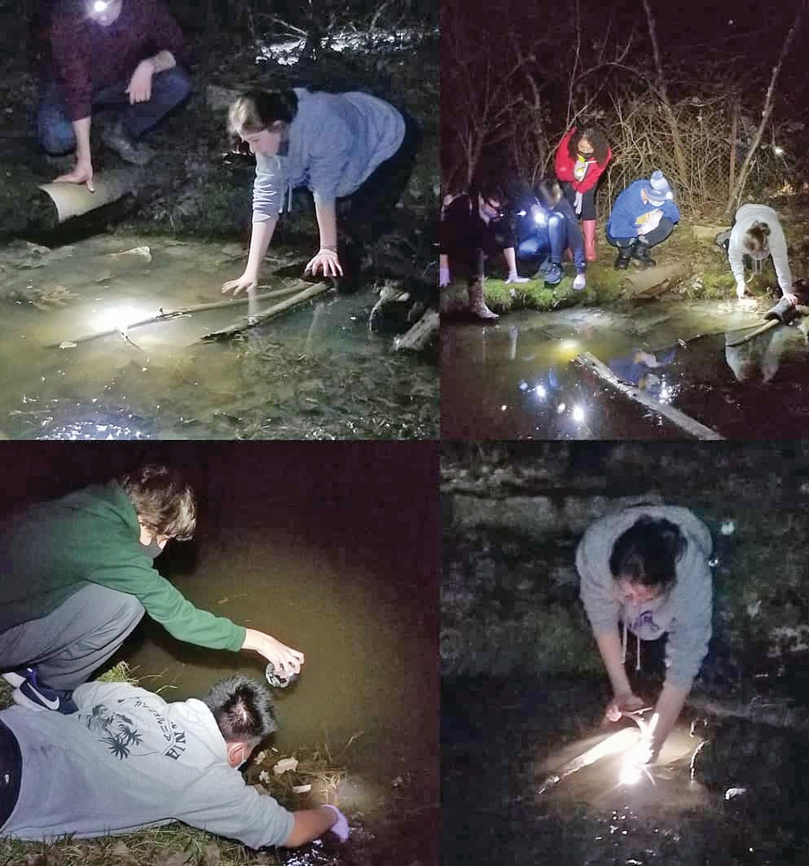Annual Amphibian Adventure takes place at Land Lab
by Laura Straub
On Friday March 26, Independence Biology Society (IBS) students were in for an adventure. The group joined Independence High School biology teacher Scott Maretka for his annual Amphibian Adventure, an event he’s held for more than 20 years, first at the Brecksville Metroparks and now at the Land Lab.
The adventure consists of observing various amphibians during their breeding season, for example, a salamander migration or frogs calling. This year, the young biologists identified Jefferson salamanders, spotted salamanders, spotted newts, green frogs and spring peepers.
“The annual Amphibian Adventure is one of my favorite experiences,” said senior IBS member Josette George. “It encompasses everything that makes me excited about biology. I feel as an active part of nature, rather than an observer.”
Sophomores Chole Firrell and Anna Zdolshek agreed, adding that it was their ideal Friday night.
According to Maretka, the students signed up to be on a call list, and he would notify them when the conditions were favorable for the amphibians, typically the first rainy days that are 50 degrees or warmer.
“It is our version of March Madness, trying to predict when the amphibians are going to emerge for spring breeding,” said Maretka. “Biologists are doing this all over the world at different times of the year, and in Northeast Ohio, March and April are the months to keep an eye on.”
According to Min Keung, the center manager at the Brecksville Nature Center, the time period for the amphibian migration in the Brecksville Metroparks is usually March 15 through April 15, when they travel to the vernal pool to mate and lay their eggs.
“The weather has to be just right for the amphibians to migrate. This is very hard to predict, but in general, there needs to be some rain or moisture throughout the day, they migrate after the sun sets and it must be above freezing,” Keung said. “The most difficult question we get is, ‘When will they migrate?’ We predict based on the weather, and sometimes we are wrong, and sometimes we are right.”
Observing the migration is important, because amphibians are bio-indicators.
“They are sensitive to pollution and chemicals, which may be in the lotions or sanitizers on our hands,” said Keung.
They are also sensitive to direct interaction with humans.
“In recent years, the amphibian migration has faced intense pressure by people. While well-meaning, I have witnessed people touching the amphibians or even accidentally stepping on them. We sometimes have more people show up than amphibians,” said Keung. “Because of this, we would prefer not to disclose the location so that the amphibians can be protected for future generations.”
She added that if people do want to get more involved with the park and environmental issues, they always welcome volunteers.
As for the IBS, they will continue their excursions into nature at the Land Lab.
“The goal for this event, as with all IBS events, is education through experiencing the natural world. Getting students out and experiencing the natural world around them while promoting awareness about biodiversity of amphibians, importance of habitat, life cycles and conservation,” Maretka said. “Through such experiences, students strengthen their appreciation for the natural world, and in return share that information with others.”
What adventures are next for the IBS and the Land Lab? Maretka has Land Lab hikes, pond and stream studies and a Reptile Adventure planned for the coming weeks.
“We are always looking forward to our next outdoor adventure,” he said. ∞

